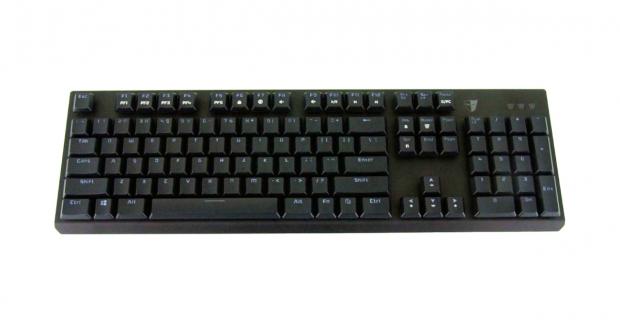
The Bottom Line
Introduction, Specifications, and Pricing

Tesoro may be a newer name to some of you, but for us, we have had near a handful of mechanical keyboards from them in the past. Whether looking at the Tizona, either of the Lobera models, or even the Excalibur keyboard, we have found them to be for the most part reliable and built very well. Even if you were not a fan of the dual board design of the Tizona or the oversized Lobera designs, and something like the Excalibur was not enough for you, Tesoro has something completely new up their sleeves this time around to attract even the most discerning of buyers.
Since Tesoro has a good handle on what the mechanical keyboard users require from these kinds of products, and exhausting the usual avenues with previously released products, they have decided to come up with something new to stand out in the crowd. As we have seen from Corsair already with their Cherry MX Speed switches, Tesoro is taking the same line of attack and is opting to offer their mechanical gaming keyboard where speed in use is the primary goal. This is not to say that the keyboard is vanilla with some new fancy switches, quite the opposite in reality. In cooperation with Kailh, Tesoro delivers a keyboard with 1.5mm actuation to the switches, and to simplify things further, the caps that cover each switch stand only 6.2mm in height. This is the driving force to which this new keyboard can claim that it is faster than a standard keyboard, but the options don't just stop there.
For those interested in the latest technology afforded to the mechanical keyboard game, you have to stop and have a look at this Gram Spectrum from Tesoro. This mechanical keyboard is built with reliability and longevity in mind, and boasting the Spectrum naming, we know that this is also full RGB backlit capable. The Gram Spectrum does have something for everyone, and even if you are looking for your first mechanical keyboard, it seems the time is ripe for the picking. As technology advances, there are those that stick to their guns with a standard design, yet at the same time, a select few companies lead the charge into the next evolution. Tesoro happens to be one of those companies that do not want to sit around and wait, and in the Gram Spectrum mechanical keyboard you are about to see, this fact is plainly on full display.
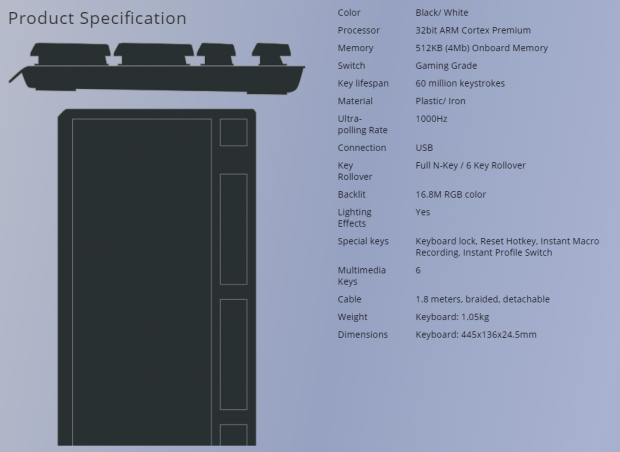
The Gram Spectrum is available in two colors. One of them offers a black frame and key caps, while the other is delivered with a white frame and white key caps. Both are controlled by a 32-bit ARM Cortex processor, and either version offers 512KB of onboard memory. The switches are marked as "Gaming Grade", and are Kailh blue switches with clear tops on them in our sample. We do also see red switch variants out in the market as well. Each key will click for up to 60 million times, ten million more than the standard offerings, and the Gram is comprised of plastic for the lower frame, double shot keycaps, and an exposed steel top plate.
The Gram has the option to poll at 1000Hz, it is connected via a detachable 1.8 meter long braided cable, and can be swapped between 6 Key Rollover mode, or put in full NKRO mode. Since the Spectrum line is Tesoro's RGB naming, the 16.8 million color options should come as no shock. These can be set to lighting effects, or customized down to the per-key level. There are a few special keys for Macros and profiles, plus six multimedia keys to add a bit of dual functionality to the top edge of the Gram Spectrum. The last thing we are shown is that the Gram Spectrum weighs in at 1.05kg, it is 445mm wide, 136mm deep, and only 24.5mm in thickness.
There are a few things that did not make the specifications chart as well. Things like the per-key programmability of this 104-key QWERTY keyboard. Judging by the dimensions, it is not hard to tell that the design has been optimized for a low-profile aesthetic all the way around. Along with the on-the-fly Macro capabilities, there is an intuitive software suite that comes along with the Gram Spectrum to gain the utmost control of all of its features. There is a one-year warranty on all Tesoro products, from the date of purchase, and with it being so thin and being offered with a detachable cable, it makes for an excellent travel companion.
As we took off to shop for the Tesoro Gram Spectrum, we did notice there is a slight deal to be had. While Amazon is selling both the white and black versions at $139.99 no matter the switch type, Newegg does come in slightly more affordable. It is here where we saw the Tesoro Gram Spectrum listed at just $129.99, and again the color or switch type had no effect on pricing. Since the K65 from Corsair is the only actual competition for this type of design, when it comes to pricing, they are neck and neck with each other. At this point, all we need to do is put forward what we see, and see just how well the averagely priced Gram Spectrum compares, not only to the direct competition but against everything else on the market right now.
We feel that by the time we are done, you will easily grasp the worth of a product such as this. Why not be on the bleeding edge of mechanical keyboard technology? The price nearly demands the fact you should be looking past some of the great, yet aging keyboard designs of the past.
Chad's Peripherals Test System Specifications
- Motherboard: ASUS X99-E WS - Buy from Amazon / Read our review
- CPU: Intel Core i7 5930K - Buy from Amazon
- Cooler: Corsair H100i GTX - Buy from Amazon / Read our review
- Memory: KLevv Cras DDR4 3000 - Buy from Amazon / Read our review
- Video Card: ASUS GeForce GTX 980 Matrix Platinum - Buy from Amazon / Read our review
- Storage: Intel 730 480GB - Buy from Amazon / Read our review
- Case: SilverStone TJ11 - Buy from Amazon / Read our review
- Power Supply: Corsair AX1200 - Buy from Amazon / Read our review
- OS: Microsoft Windows 10 Professional 64-bit - Buy from Amazon
Packaging, Accessories, and Documentation
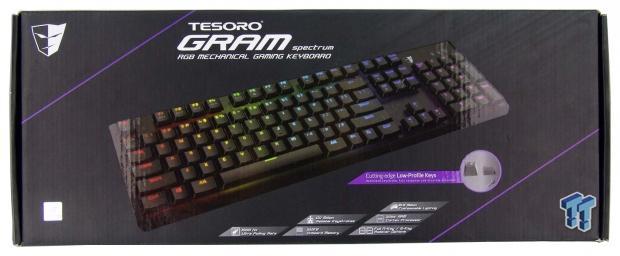
The Tesoro Gram Spectrum ships to your door inside of this black box with two thin purple accent lines. At the top, we see that this is an RGB mechanical keyboard, just above the glossy image of the Gram Spectrum. There are notations to the "cutting edge" low-profile keys, the polling rate, switch lifespan, amount of onboard storage, amount of color options, what controls it, and its modes of rollover support.

The naming and some of the features can be found on the left end of this panel, but what we found here is more important. We are shown where to go to get drivers and software, we are shown this is a US layout keyboard, it is also known as the TS-G11SFL, and out of the switch options, we see this has blue switches in it.

At this thin end of the box, we can see tiny images of both models of the Gram Spectrum, and of them, the black version is marked. At the right, we see what is required to use the Gram Spectrum, as well as what can be found inside the box.
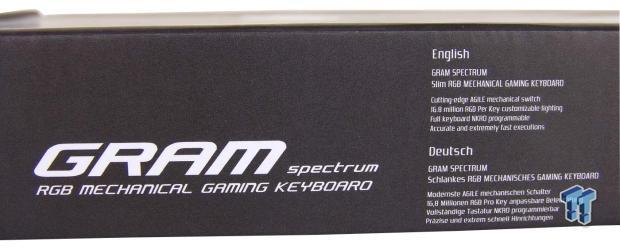
The larger text of the product name is found near the left end of this side. In a total of 11 languages that follows off to the right of this image, we see a brief description of what the Gram Spectrum is all about.

Along with some iconography and legal mumbo jumbo, moving toward the right shows that this Gram Spectrum is designed by Tesoro, and they are a US company. The notation at the right shows that this is compatible with Windows 8, but we found it also fully ready for Windows 10 as well.
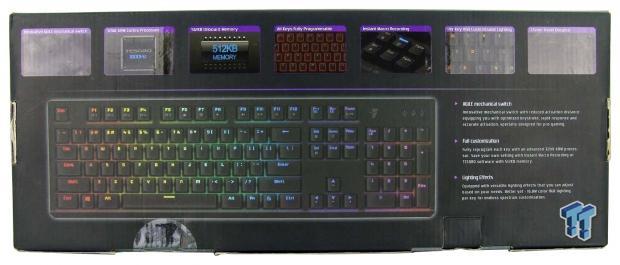
On the back of the box, along the top, we find images of the key features found in, on, and around the Gram Spectrum. There is a large image of the keyboard with the Spectrum Effect enabled, and RGB lighting on full display. To the right, Tesoro mentions the switches again, the keyboards full customization, and even gets into some of the effects that can be used for the eight total modes.
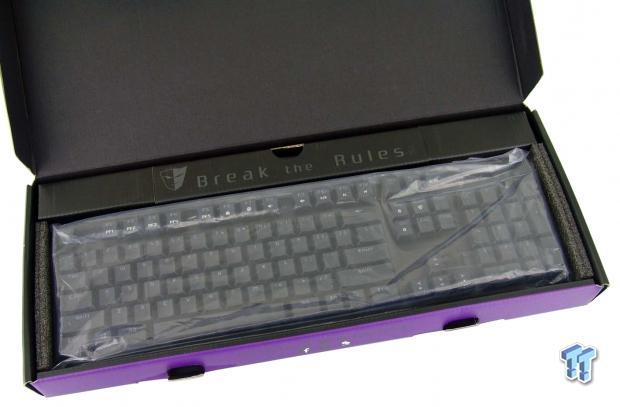
A plastic liner protects the coatings of the Gram Spectrum, and we can see there are also sections of dense foam at either end. The cable comes bound in the back of the box, and lifting the section which says "Break the Rules" we can remove the cable and locate the paperwork.
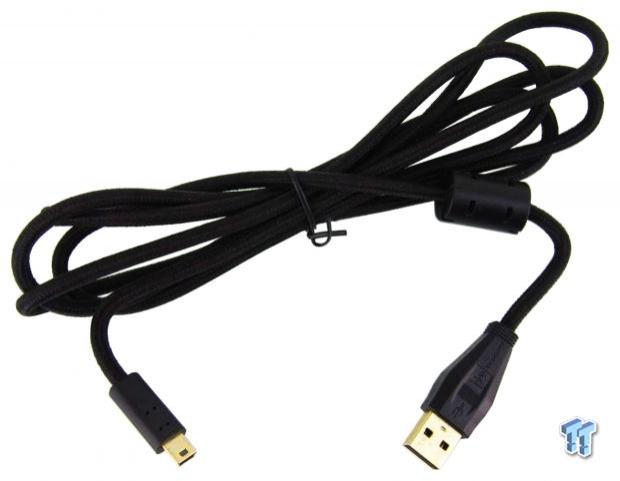
In case you had forgotten, Tesoro took a page from Cooler Master with this keyboard, and is offering a fully detachable USB cable. The length of the cable is braided in black cloth, the ends are gold plated, and there is even a Ferrite choke near the end that connects to the PC.
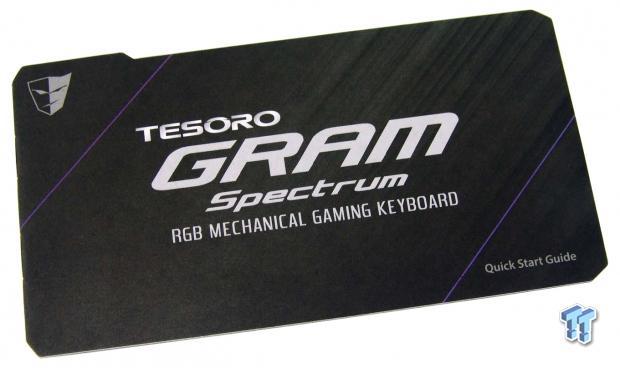
The quick start guide for the Gram Spectrum starts off explaining their approach, moves into a itemized list of features with a rendering noting where each of them is. Flipping the page welcomes you to Tesoro World, gives you the name of the product, what comes in the box, and ends with the system requirement. With a four-step process of installation, all that the guide leaves to see contains all of the secondary keys, and what their specific functions are.
Tesoro Gram Spectrum Mechanical Keyboard

The first glance at the Gram Spectrum, from its left edge, shows just to what extent Tesoro went to for the low-profile design of this keyboard. The frame is thin at the bottom, and with an exposed top plate, they are already saving some height. We can see the switches extending past the top plate, and we also see the half-height key caps that rest on all of the switches.
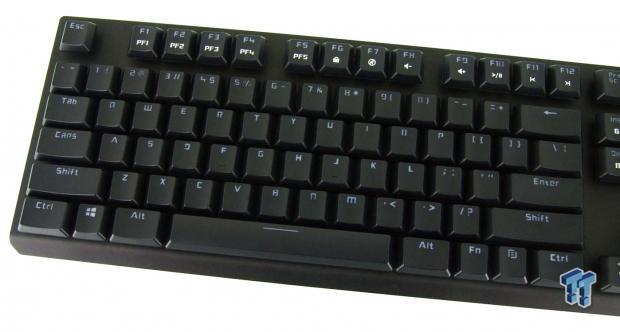
The layout of this 104-key US layout keyboard is a standard QWERTY setup, but Tesoro has chosen an unusual font for the numbers and letters. The top row of keys will offer double duty, but the remainder of the left side of the Gram Spectrum is relegated to standard duties.
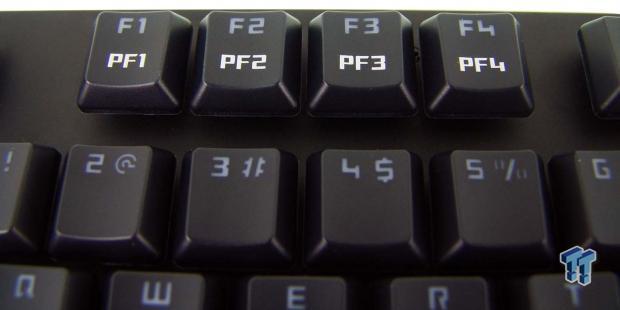
Along with the press of the Function key, using F1 through F4 allows you to swap through the profiles. These can be programmed via software, but cannot be set on-the-fly or adjusted in any way outside of the software suite.
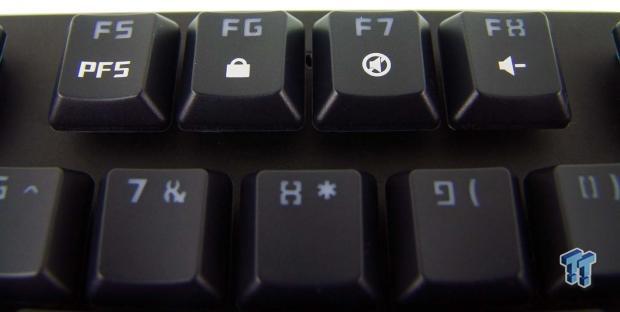
F5 offers the last of the five profile buttons, and the F6 can be used to disable the entire keyboard so that children or pets do not cause a catastrophe. The F7 keys will mute all sounds, and the F8 will reduce the volume of the PC attached to this keyboard.
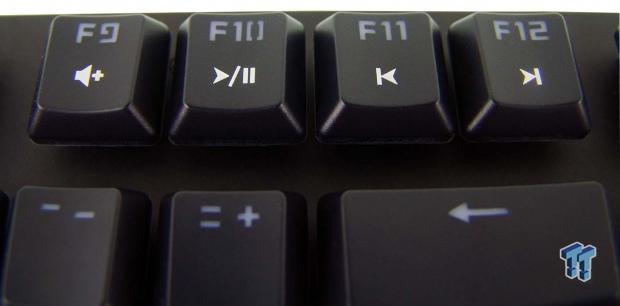
The F9 key will increase the volume, and the F10 is used as the play/pause multimedia function. Continuing in the multimedia keys, the F11 goes back a track, and F12 will move forward one track.
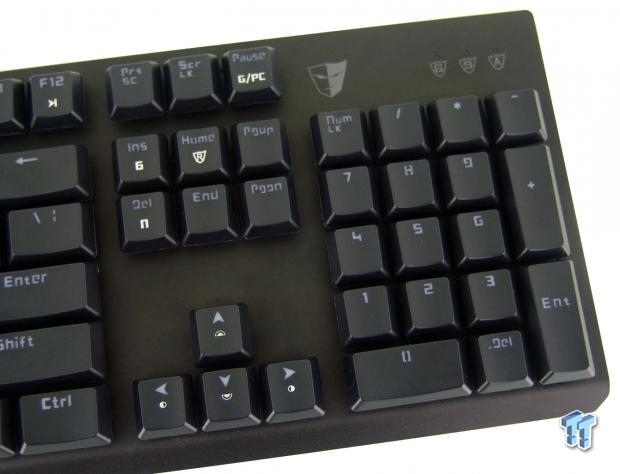
The command keys, arrows, and the number pads offer all of the usual suspects, and we do see dual functionality on eight of these keys. At the top, to the right of the Tesoro logo, there is the Game lock LED, one for the Number lock, and the last one is for the Caps lock. These LEDs will illuminate in blue only, but every other LED on the board is RGB.
Tesoro Gram Spectrum Continued
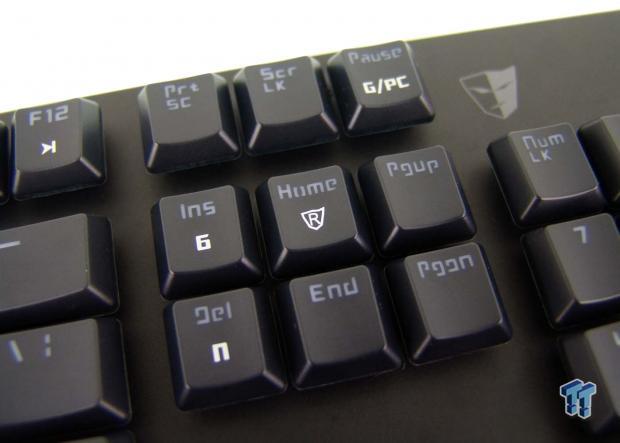
On the command keys, we find four of the secondary keys on the right third of the keyboard. On the Pause key, you can swap between Game and PC modes, the Insert key will set 6 key rollover, the Home key will turn on the on-the-fly Macro record function, and the Delete key will set the Gram Spectrum into NKRO mode.
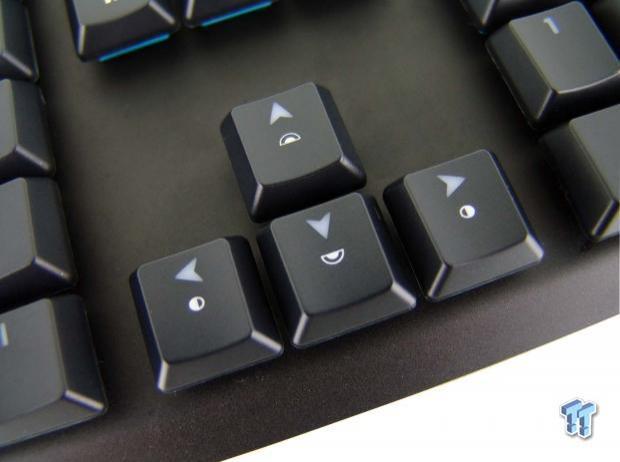
The arrows also see double duty. Using the up and down arrows, you can adjust the LED intensity from off, to 25, 50, 75, and 100 percent. Using the left and right arrows will cycle through the LED modes, and these are the default of a solid color, trigger, ripple, firework, radiation, breathing, wave, and spectrum.
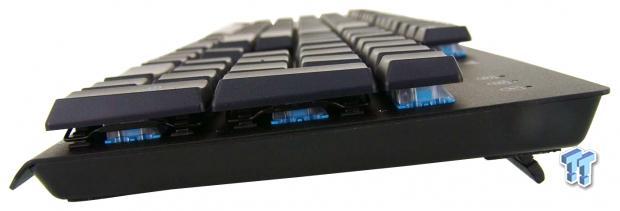
Even with the feet extended at the back, offering up a better angle of attack to the 6.2mm tall keycaps, it is hard not to see just how thin the entire design is.
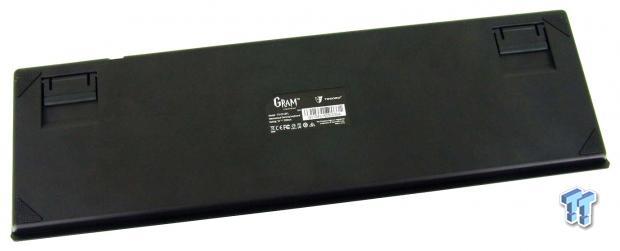
The lower section of the frame, once the keyboard is flipped on its face, we see it is almost entirely flat. There are large triangular feet at each of the corners, and the product sticker is somewhat inset, and the wide feet are inset as well. This leaves a flat textured surface, and along the front is the edge of the steel plate wrapping over the base.
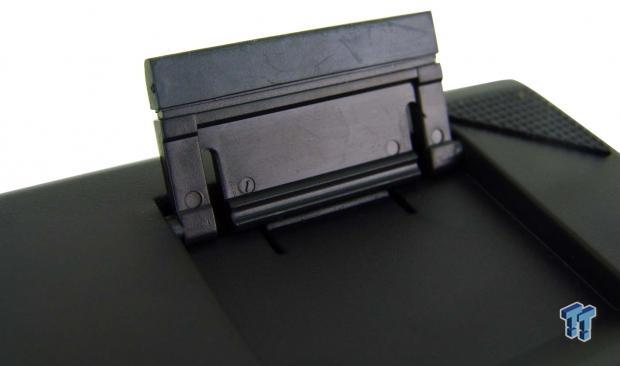
The ends of the flip out feet are rubberized, and these are some of the widest feet we have ever seen. After a little effort getting the feet to flip out, they do angle to the back enough that they should not cause issues, but there is not a solidly locked position. If you were to scoot this keyboard, the feet will easily collapse.
Inside the Gram Spectrum
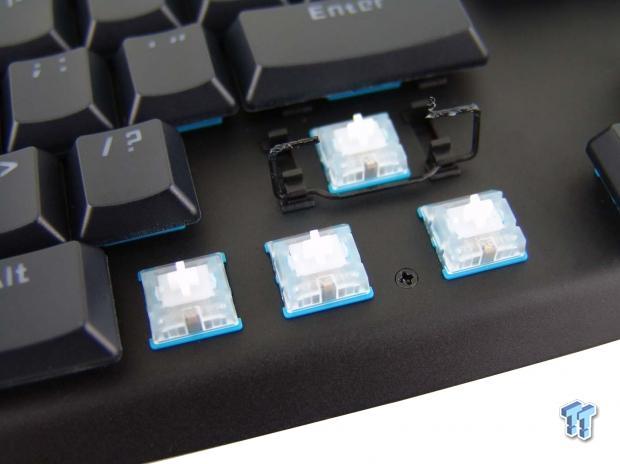
Step one, remove keycaps and verify switches. Check. Here we find Kailh branded light blue switches, which are made with a clear top section. With LEDs built into the interior of this switch, it only makes sense to have a clear top to allow the light to pass through them, into the keycaps. We can also see that the torsion bars are exposed in this design, and we also see Tesoro greases them to cut chatter in the keycaps as well.
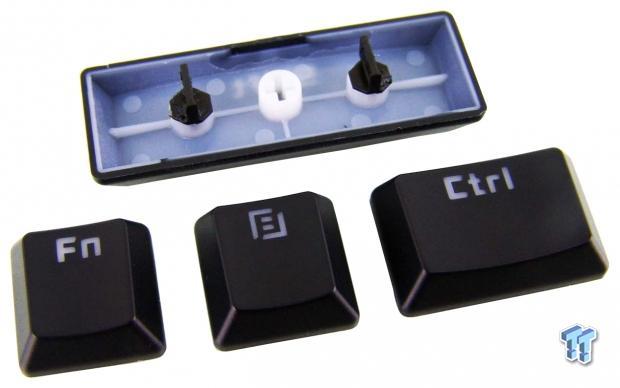
Each of these 6.2mm keycaps are double-shot caps. This means that an initial casting is made in the translucent white inner caps, and are molded with the numbers, letters, and icons on them. The caps are then molded in black, with the white inserts in place, leaving just the legend exposed at the top, and will not wear anywhere near as fast as painted caps will.
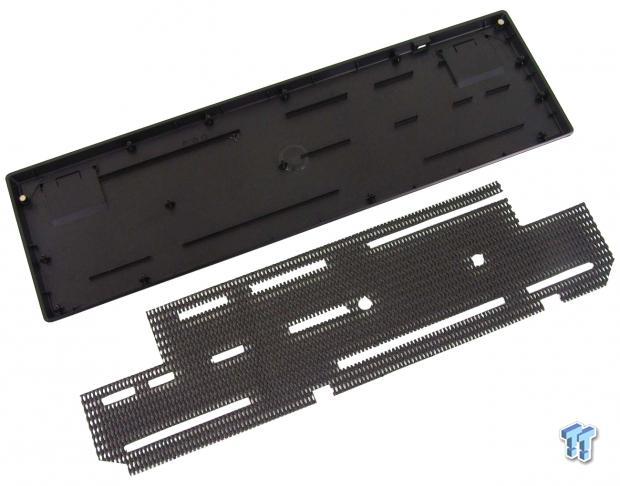
After removing around a dozen or so screws from the top plate of the keyboard, we were able to separate the halves. The lower plastic section is raised in areas to help support the steel plate, where it will not cause issues to the soldering. They also took the extra step to insert padding between the lower section, and the back of the switches. This does two things, it closes the gap between them, which offers isolation, but also is shock absorbent, reducing vibrations.
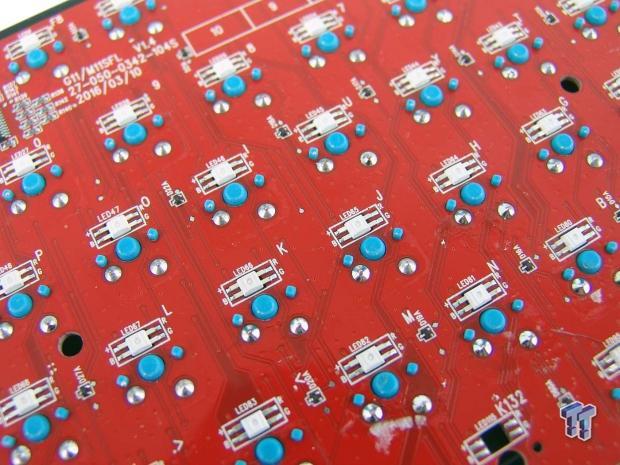
Picking a random spot on the bright red PCB, we see a fine attention to detail has been paid to the soldering and flux removal. There is a bit of sticker residue near the bottom, but it should not affect the electronic signaling these solder points give.
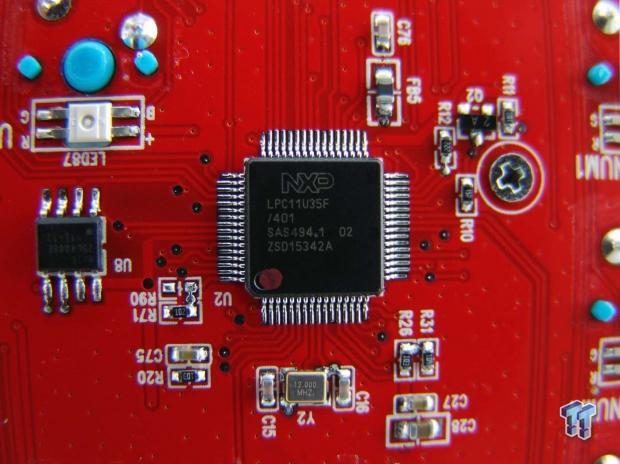
The 32-bit ARM Cortex processor for the Gram Spectrum is made by NXP. We find the LPC11U35F in control of this keyboard, and with its specifications, it is enough to deliver everything we have spoken on about the capabilities of this design.
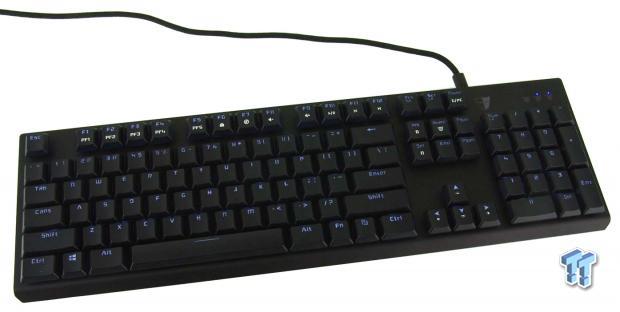
When we first powered the keyboard, we set a few of the Locks as activated, showing their blue LEDs, but at the time of powering it up, you were given the Spectrum effect for a few seconds upon loading. After loading the device, it quickly reset to this solid blue coloring we see in this image.
Gram Software
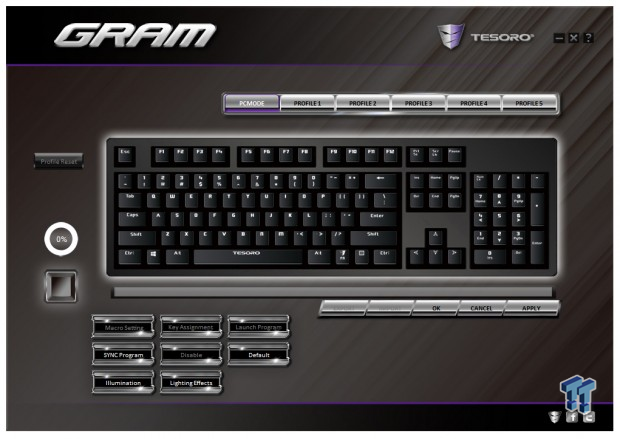
After visiting the support page of the Tesoro site and grabbing the software, after installation, this is what we see first. Along the top, you can select the profile you wish to program, but if it is set in PC mode, you will notice many of the options at the bottom are grayed out. To the left, the amount of memory used is shown, and a large image of the keyboard sits in the middle. In PC mode, we can only access the Sync Program feature, the Illumination settings, Lighting Effects, and being able to set this profile back to factory defaults.
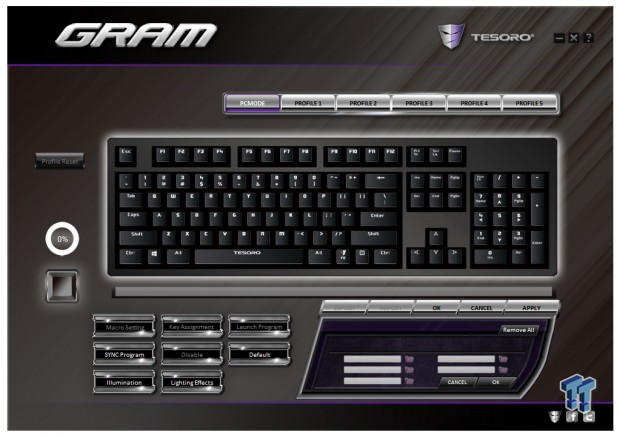
If you were to click on the Sync Program bar, the bottom right corner of the window changes. This new menu has arrived, and in it, you can browse for programs, mostly games and editing suites, but this allows a profile to boot when the program is loaded.
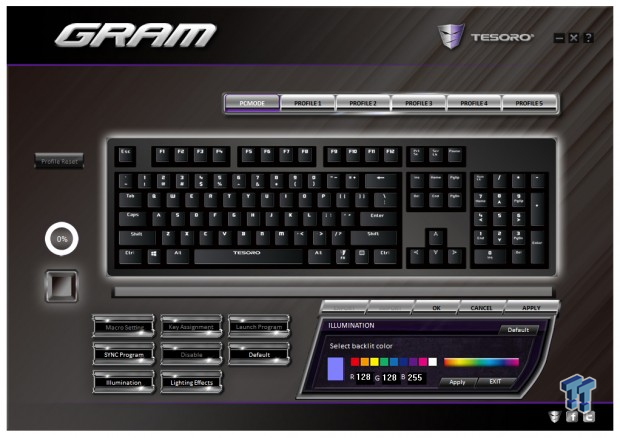
Illumination allows you to set the entire keyboard backlight color when in PC mode. You can select from presets, use the bar to the right, or enter your RGB code numbers to adjust it. When in profiles one through five, when keys are selected for programming, this is also where you will do that.
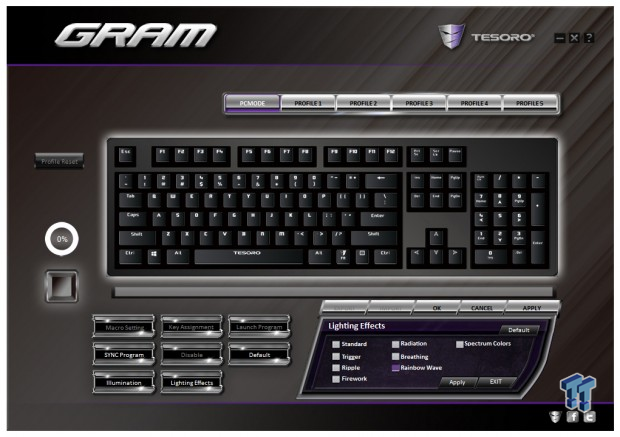
Lighting Effects offers eight ways for the LEDs to react or be displayed. Standard is all one color of LEDs, trigger means it lights when pressed, and ripple sends light away from each keystroke. Fireworks make a small explosion around the key, and radiation sends light left and right of the key being pressed. Breathing is standard, there is a rainbow wave which moves to the right, and Spectrum, by default, illuminates the most used gaming keys on the left.
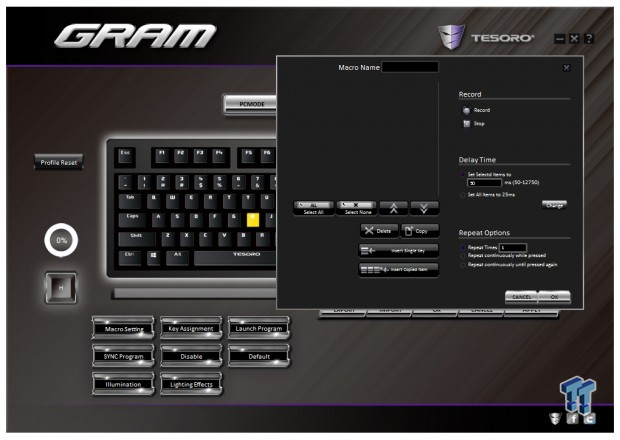
By selecting one of the five profiles, all of the options become available. So far, we have started back at the beginning of the tabs and opened the Macro Settings. In here you can select a key to set the Macro to, name it, record it, and edit it all you want. Once set up, be sure to save before closing this window, and again before you close the main window, as it will then be stored in the keyboard's onboard memory.

As for Key Assignment, there is that option as well. This will allow for a complete remap of the entire keyboard if desired. You can also disable keys now, as well as opening the launch Program option, where a single key press will open any program you have installed on the PC.
Gaming and General Impressions
DOOM
To be blunt, we feel that in our quest to complete the single player mode of DOOM, the Tesoro Gram Spectrum has aided us to pass boards we could not do before its usage. Finding less searching going on, and the fact that it is hard to press multiple keys with the thinner key caps, only the movements we were trying to put out is what we got.
We liked the report from these Kailh blue switches, and we can feel the speediness of our actions due to what is shown to be a shorter throw to actuation. Even being as thin as the Gram Spectrum is, even when pressing buttons like a mad man, we felt no vibrations or anything to give off a cheap-ish feel to its usage.
Overwatch
Overwatch gave us the chance to go ahead and play around with the profiles and remapping, as the stock position of some of the most important game commands were odd for us to use. Once we had everything easily within reach, we do have to say that this game has become more enjoyable to play, without have to extend ourselves to find the default layout actions.
Again, with fast-paced, close quarter action of this game, the Gram Spectrum responds fully and gives you a sense of easier gaming and less stress to your hands after many hours of gaming.
Windows and Productivity
As far as editing is concerned, we did shift over, importing some of our go-to Macros to simplify our day. All of them worked as intended, and we even toyed around with adding a few more with this keyboard, mostly due to the way the Macro Editor worked. It is simple and easy to sort out, and the customizations are as good as it gets.
On the flip side, we have to look at this from a typist's perspective, as we just cannot game all day and still get our opinions out. We spend a lot of time with each keyboard, and much like when we used the MX Speed Switches before this, the combination of lowered keycaps and the shorter activation of the switches, has paid off in time over the long haul.
We can feel we are typing faster, and by our average WPM, on the first day, we were up ten words per minute, and things got better as we spent more time with the Gram Spectrum. We also noticed that with our fat fingers, we were not hitting multiple keys with this design, and that too saves time from not having to go back and edit mistakes.
Final Thoughts
Tesoro changed gears from what we have seen from them in the past, and it has paid off considerably. While they are not the first to bring this sort of a design forward, they did do it very well, and in our mind, competes head to head with what Corsair is offering. The Gram Spectrum is sleek, it is thin, the lighting effects are top tier, and best of all, it is built for speed. No matter how we used this keyboard, the exposed steel plate delivers the best way to illuminate a keyboard, and the vibrationless operation of the Gram Spectrum leads to less fatigue. Adding in the fact that the switch throw is shorter, and the keycaps are only 6.2mm tall, it just makes moving around on this 104 key layout a breeze. Then because the software brings out every option a gamer could want, and all of the caps are double shot rather than painted, you are buying a keyboard that will stand the test of time, above and beyond most of the mainstream competition.
The only downside we could find with this keyboard is the fact that it does not boot in Wave mode. Honestly, though, it was just a few key presses away from being seen, but it goes to show you how deep we have to dig even to attempt to find an issue. The MCU is more than capable of handling anything you can throw at it. It offers NKRO and anti-ghosting, and it can be remapped - the amount of power under your hands is impressive. There is the fact that you can record Macros on-the-fly as long as you are on a profile, and we also like the fact that not only is there a PC mode and Game mode, but you can also lock out the entire keyboard with the press of two keys. With the Tesoro Gram Spectrum, the list just goes on and on, and all of that list just bolsters the image that this product has set forth.
It is relatively easy to go out and gobble up something like the SteelSeries M500 we are currently testing, which is a well-equipped keyboard in its own right. The reality is that with the Gram Spectrum, you get RGB lighting for much less than the M500 is offered at, and we tend to gravitate to smaller keyboards, so the Gram wins out to us over the Corsair offering as well. Also, as far as we are aware, neither of them come with a white option. With $129,99 required if you shop for the best deal currently available, the Tesoro Gram Spectrum and its accompanying software shows its value.
While we are fans of Corsair's product, suffice it to say, we would rather this keyboard stay on our desk. We like the Gram Spectrum so much, it may just replace our CoolerMaster Rapid i, which has been a trooper for us over many years of service. If it were our money, we would be Fry in the meme saying "shut up and take my money."
Chad's Peripherals Test System Specifications
- Motherboard: ASUS X99-E WS - Buy from Amazon / Read our review
- CPU: Intel Core i7 5930K - Buy from Amazon
- Cooler: Corsair H100i GTX - Buy from Amazon / Read our review
- Memory: KLevv Cras DDR4 3000 - Buy from Amazon / Read our review
- Video Card: ASUS GeForce GTX 980 Matrix Platinum - Buy from Amazon / Read our review
- Storage: Intel 730 480GB - Buy from Amazon / Read our review
- Case: SilverStone TJ11 - Buy from Amazon / Read our review
- Power Supply: Corsair AX1200 - Buy from Amazon / Read our review
- OS: Microsoft Windows 10 Professional 64-bit - Buy from Amazon

